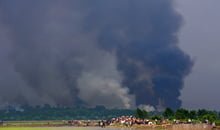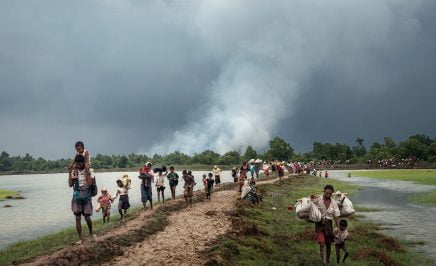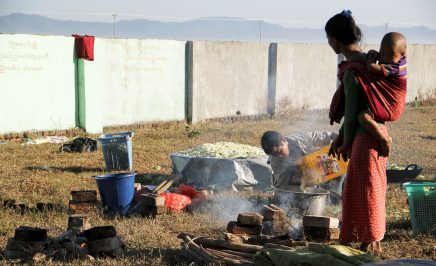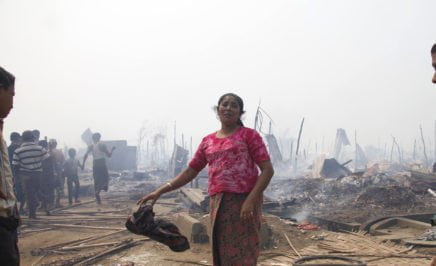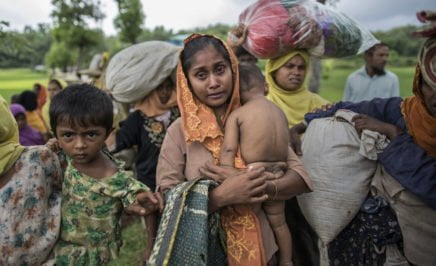Amnesty International has gathered new evidence of indiscriminate attacks on civilians in Rakhine State, amid serious escalations in the ongoing armed conflict between the Myanmar military and the Arakan Army (AA).
This evidence is based on firsthand testimony, photographs and video obtained from inside Rakhine State, and analysis of satellite imagery as well as media reports and civil society sources. Witnesses’ names have been changed.
“There are no signs of the conflict between the Arakan Army and the Myanmar military abating – and civilians continue to bear the brunt,” said Ming Yu Hah, Amnesty International’s Deputy Regional Director for Campaigns.
“The Myanmar military’s utter disregard for civilian suffering grows more shocking and brazen by the day. The UN Security Council must urgently refer the situation in Myanmar to the International Criminal Court.”
Amnesty International is also concerned at recent reports of an increased presence of Myanmar military troops along the Myanmar-Bangladesh border. Images of antipersonnel landmines recently found in a civilian area were analysed by Amnesty’s weapons expert and identified as the MM2 type landmine often used by the Myanmar military. This device is larger than most anti-personnel landmines, and typically inflicts severe damage.
Both the Arakan Army and Myanmar military use antipersonnel devices, and as such definitively establishing provenance is not always possible. Current restrictions on access preclude on-the-ground documentation efforts by Amnesty International.
Several incidents involving civilians injured or killed by landmines have been credibly reported in Rakhine and Chin States in recent months by local civil society and media outlets.
One of the most recent instances was on September 18, when a 44-year-old Chin woman stood on a landmine while collecting bamboo shoots near the Myanmar military’s Light Infantry Battalion 289 base in Paletwa. She died of her injuries a short time after.
Amnesty International also notes with alarm recent local media reports of the Myanmar military using Rohingya children for forced portering in Buthidaung Township, in an area where clashes with the Arakan Army are ongoing.
‘I didn’t think it could be our village’
On the morning of 8 September 2020, Maung Soe* was at work near his village of Nyaung Kan in Myebon Township when he heard heavy weaponry, which he describes as sounding like thunder.
“I didn’t think it could be our village. I thought it was somewhere else. I tried to call my wife and she wasn’t answering. I heard it two times — jain, jain — within one minute.
“I went to the village and I heard some people got injured. When I got home, my wife and my daughter were laid down on the floor. [My wife] was not saying anything. I tried to check my [seven-year-old] daughter and she was still alive. I picked up my daughter and tried to get out.
“I didn’t see [any soldiers]. The weapon came from very far. And when I tried to run by hugging my daughter’s body, there was more shooting. I tried to lay over my daughter’s body, near the stream. Within two minutes, my daughter passed away.
“Even after my daughter passed away, I could still hear the weapons coming… I had to run away, leaving my daughter’s body. I came back later when they stopped shooting.”
Maung Soe says there were no Arakan Army fighters in Nyaung Kan. Villagers believe the heavy weaponry was fired from a Myanmar military base near the border with Ann Township.
The shelling at Nyaung Kan village in Myebon Township claimed the lives of five people, including Maung Soe’s wife and daughter. All were from the Rakhine ethnic group, and two were seven-year-old children. Ten others were wounded in the attack.
By one local civil society group’s estimate, the number of civilians killed in this conflict since December 2018 in Rakhine and Chin States stands at 289, with 641 injured.
The true figure cannot be independently verified, as a mobile internet shutdown and broader government crackdowns on media reporting have impeded documentation efforts in conflict-affected areas. However, in July 2020, Amnesty International was able to document indiscriminate airstrikes and shelling by the Myanmar military, killing or injuring civilians, including children.
On 14 September, UN High Commissioner for Human Rights Michelle Bachelet told the Human Rights Council that in some recent cases in Rakhine State, civilians “appear to have been targeted or attacked indiscriminately, which may constitute further war crimes or even crimes against humanity.”
Maung Soe is now displaced, and says he wants to see the Myanmar military withdraw from Rakhine State to prevent further harm: “As I suffer, and as I have lost my family, I don’t want any other Rakhine people to have a similar experience in the future.”
‘One from the road and one from the mountain’: Burned village attacked from two directions
Satellite analysis and new witness testimony gathered by Amnesty International suggest that Myanmar soldiers burned a village in central Rakhine State’s Kyauktaw Township in early September.
One witness, villager U Kyaw Tin*, who lives in the area, told Amnesty International that he was walking with his cow when the Myanmar military launched an assault on Hpa Yar Paung began on 3 September.
“[They] started shooting, they entered the village. I didn’t know exactly where the shooting came from … We were trying to run to the other side. We didn’t really see what exactly was going on, because we all were running.”
He said that it appeared the village was closed in on by the Myanmar military from two directions: “Two [sets of] troops, one from each side – one from the road and one from the mountain. There was also shooting from [a remote location], but there was also something from the roadside, coming in by car.”
A spokesperson for the Myanmar military, Major General Zaw Min Tun, told journalists a police vehicle was attacked by the Arakan Army with a remotely detonated improvised explosive device (IED) near the village.
